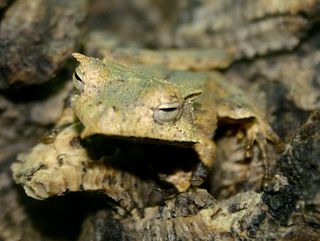
The Hemiphractidae are a family of frogs from South and Central America. Previously, this group had been classified as a subfamily (Hemiphractinae) under family Hylidae. More recent research classifies these genera into their own family, or sometimes into three separate families: Amphignathodontidae, Cryptobatrachidae, and Hemiphractidae (Hemiphractus). An active question still exists as to which of these groupings is more accurate.

Callechelys marmorata, also known as the marbled snake eel, is a benthic marine fish belonging to the family Ophichthidae which refers to serpentine in shape fishes.
Hylaeus krombeini is a bee species endemic to Asia.
Lipotriches fervida is a species of bees in the genus Lipotriches, of the family Halictidae.
Lipotriches pulchriventris is a species of bees in the genus Lipotriches, of the family Halictidae. It is widespread in Southeast Asia and variable in appearance, and has been given numerous names since its original description.
Lipotriches edirisinghei is a species of bees in the genus Lipotriches, of the family Halictidae.
Ceylalictus appendiculata is a species of bees in the genus Ceylalictus, of the family Halictidae.
Ceylalictus horni is a species of bees in the genus Ceylalictus, of the family Halictidae.
Ceylalictus cereus is a species of bees in the genus Ceylalictus, of the family Halictidae.
Lasioglossum cire, also known as the Lasioglossum (Ctenomia) cire, is a species of bees in the genus Lasioglossum, of the family Halictidae.
Lasioglossum semisculptum, also known as the Lasioglossum (Ctenomia) semisculptum, is a species of bees in the genus Lasioglossum, of the family Halictidae.
Lasioglossum vagans, also known as the Lasioglossum (Ctenomia) vagans, is a species of bee in the family Halictidae.

Lasioglossum halictoides, also known as the Lasioglossum (Nesohalictus) halictoides, is a species of bees in the genus Lasioglossum, of the family Halictidae.
Lasioglossum serenum, also known as the Lasioglossum (Nesohalictus) serenum, is a species of bee in the genus Lasioglossum, of the family Halictidae.
Lasioglossum alphenum, also known as the Lasioglossum (Sudila) alphenum by Sakagami et al. (1996), is a species of bees in the genus Lasioglossum, of the family Halictidae.
Pseudapis oxybeloides is a species of bees in the genus Pseudapis, of the family Halictidae. It is a soil nesting type of bee. It is known to be a major insect pollinator in the world.
Sphecodes crassicornis is a species of bees in the genus Sphecodes, of the family Halictidae.
Sphecodes decorus is a species of bees in the genus Sphecodes, of the family Halictidae. S. decorus has been documented in India and Sri Lanka.
Steganomus nodicornis is a species of bees in the genus Steganomus, of the family Halictidae.
Systropha tropicalis is a species of bees in the genus Systropha, of the family Halictidae.




